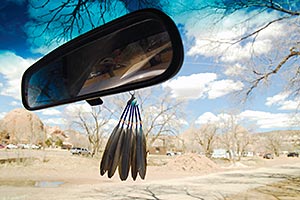Fed crackdown on feathers aims at illegal sales
By Bill Donovan
Special to the Times
WINDOW ROCK, April 16, 2009

(Times photo - Donovan Quintero)
A fan of feathers hangs from a motor vehicle's rearview mirror in the Window Rock area Monday.
P owwow season is getting underway and many on the circuit are wondering how much of a hassle they may encounter if they publicly display eagle feathers on their person or in their car.
The answer to that from the U.S. Fish and Wildlife Service is probably none if they are Native American and are not trying to profit commercially from the sale of eagle feather products.
Steve Oberholtzer, who works in the law enforcement branch for the Fish and Wildlife Service in Denver, said there may have been concerns raised in recent weeks because of a surge in arrests that have been made by the agency, mostly in the western portion of the United States.
"But all of these have dealt with illegal commercial sales," he said, adding that the agency's emphasis has been in trying to keep eagle feathers from being sold on the Internet and elsewhere.
Some of those who have been arrested have been Native American but Oberholtzer stressed that no Native American has been arrested for only possessing eagle feathers or having them hanging from a mirror in their car.
Just last month four persons, at least one of whom was a Native American, were arrested on illegal feather charges.
Reginald D. Akeen, 33, an enrolled member of the Kiowa Tribe, was arrested on March 12 in Albuquerque because of allegations that he was selling illegally obtained bald eagle and golden eagles as he traveled the powwow circuit.
On March 12, three other men from the Washington area were also arrested for hunting eagles and selling eagle feathers and parts to an undercover agent. The three were identified as Ricky Sam Wahchumwah of Granger, Wash., and Alfred L. Hawk Jr. and William Wahisise, both of White Swan, Wash.
On the Navajo Reservation, Fish and Wildlife agents recently raided the home of a man in the Tuba City area, removing an eagle carcass from his home although he showed them a permit allowing him to own it.
That investigation was spurred, however, by reports that he was selling feathers on the Internet. He said he was selling feathers in the past but none of them were illegal.
While Native Americans who have eagle feathers in their possession may be asked where they got them from, Oberholtzer said that there is no requirement to have a federal permit showing that the feathers were obtained legally through the federal repository.
The repository, located in Denver, receives eagle and hawk carcasses from all over the country and then distributes them to Native Americans who file an application saying they want the feathers or bird parts for ceremonial purposes.
When they get the items, the federal government provides a permit showing where they received the items from.
But it's quite common, Oberholtzer said, for Natives to give or transfer the feathers and carcasses to a relative or friend. There is no law against this, he added, as long as there is no money involved.
Federal agents also keep track of sales that are going on the Internet but sales through eBay and other auction sites have slowed down once sellers realized that the federal government was keeping track of what was being sold.
Oberholtzer said that these individuals may have believed that they could sell the items safely by being anonymous on the Internet but the agency has ways of tracking down the seller. Also, the seller couldn't be sure that the person on the other end wanting to buy the item was not an undercover agent.
The increase in arrests may also be due to the fact that prices for eagle feathers, especially tail feathers in prime condition, are soaring.
In the Washington case, undercover agents paid $500 for one golden eagle tail feather.
Oberholtzer said the demand for eagle feathers and carcasses is also increasing from Natives which is why the number of applications to the repository is also on the increase.
Natives have complained that it sometimes takes months and a year or more to get their request filled but Oberholtzer said the reason for the delay is that some types of feathers are not available in the numbers to meet the demand.
"As soon as a feather or carcass comes in, it's sent out within a week," he said, "so what's causing the delay is supply."
The agency, on its Web site, gives Natives an idea of how long it will take for their application will be filled.

